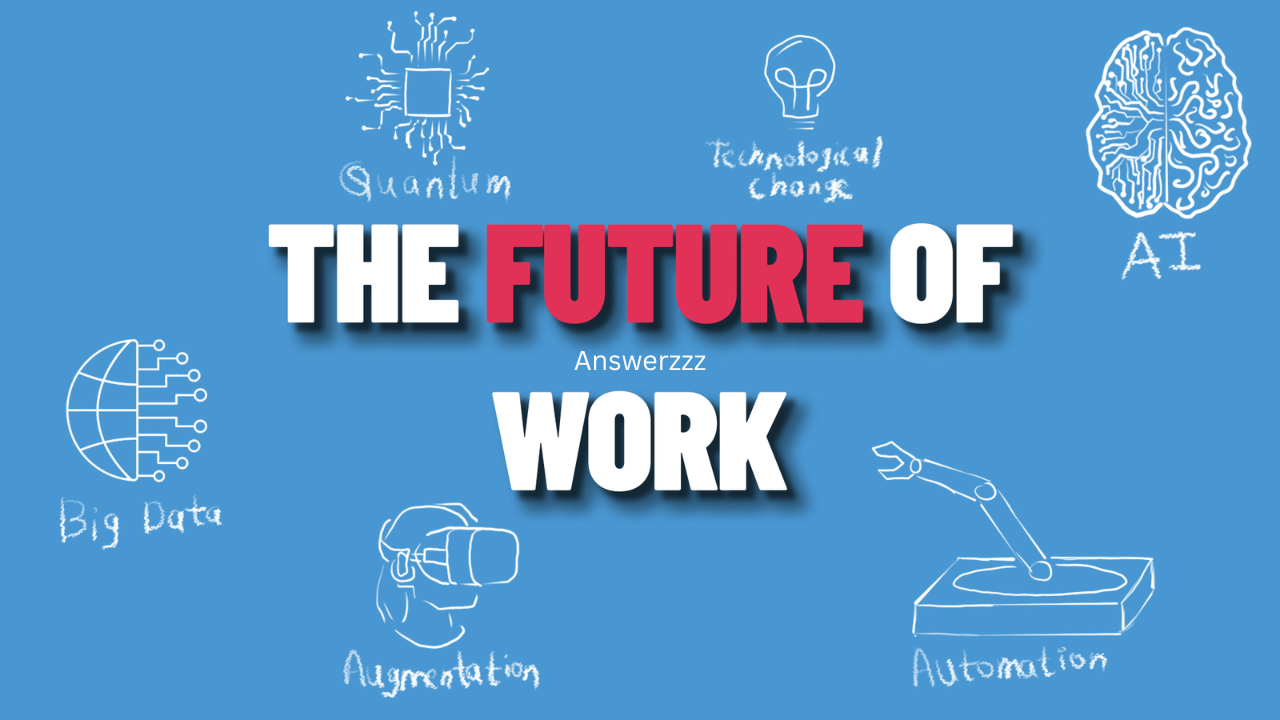In the rapidly evolving landscape of technology, the future of work is one of the most significant areas where we can expect profound changes by 2025. The acceleration of digital transformation, driven by advancements in artificial intelligence (AI), machine learning (ML), automation, and connectivity, will reshape industries and redefine how we work, where we work, and even why we work. Remote collaboration, a trend that saw exponential growth during the COVID-19 pandemic, will continue to evolve, bolstered by more sophisticated tools and platforms.
As we approach 2025, several emerging technologies are set to disrupt traditional employment models, alter job roles, and create new opportunities in a globalized, digital-first work environment. This article explores how the workplace will transform by 2025, with a focus on jobs and remote collaboration, and the technological innovations driving this change.
The Evolution of Remote Work and Collaboration

The Rise of Remote Work: A Permanent Shift
The pandemic-induced shift to remote work was initially seen as a temporary necessity, but it has since become a permanent fixture of the modern work environment. According to a report by Gartner, 82% of business leaders plan to allow employees to work remotely at least some of the time post-pandemic, and many organizations have transitioned to hybrid models where employees split their time between home and the office.
By 2025, remote work will have become the norm for many industries, supported by technological advancements that make it easier, more productive, and more seamless. Tools like video conferencing, project management software, and digital collaboration platforms are continually improving, allowing for real-time communication, project tracking, and workflow automation.
Enhanced Virtual Workspaces: The Next Frontier
Virtual workspaces will take on new dimensions with the growth of virtual reality (VR), augmented reality (AR), and mixed reality (MR) technologies. These immersive technologies will enable more lifelike remote collaboration, allowing employees to work in shared virtual environments as if they were physically together. By 2025, VR and AR platforms will be more accessible and integrated into mainstream work processes, offering enhanced engagement for meetings, training, brainstorming sessions, and team-building activities.
Emerging Technologies to Watch in 2025: AI, Quantum Computing, and Beyond
Facebook’s rebranding to Meta in 2021 highlighted the increasing interest in the “metaverse,” a virtual world where people can interact, work, and socialize. In the context of work, the metaverse could be the next iteration of remote collaboration, offering employees immersive environments that simulate in-person experiences, without the need for physical presence.
5G and the Future of Connectivity
The rollout of 5G technology is another critical enabler of the future of work, particularly in the realm of remote collaboration. 5G promises ultra-fast internet speeds, reduced latency, and the ability to support a massive number of connected devices simultaneously. For remote workers, this means smoother video conferencing, faster data transfers, and better performance for cloud-based applications.
In 2025, 5G will allow remote workers to engage in more bandwidth-intensive activities, such as real-time video editing, 3D modelling, and data visualization, from anywhere in the world. As a result, the digital divide between remote and in-office workers will diminish, leading to more equitable collaboration and productivity.
The Role of AI and Automation in Job Redefinition
AI and Automation: A Double-Edged Sword
While technological advancements will create new opportunities, they will also lead to the automation of many tasks traditionally performed by humans. AI and automation are already transforming industries such as manufacturing, healthcare, finance, and logistics by streamlining operations, reducing errors, and increasing efficiency. By 2025, these technologies will play an even more significant role in reshaping job roles.
AI-driven tools will increasingly handle routine, repetitive tasks, freeing up employees to focus on more strategic, creative, and interpersonal aspects of their work. For example, in customer service, AI-powered chatbots and virtual assistants will handle most routine inquiries, while human agents focus on more complex or sensitive issues.
However, this shift also raises concerns about job displacement. According to a report by the World Economic Forum, automation could displace 85 million jobs globally by 2025, but it could also create 97 million new roles in fields like AI, data analysis, content creation, and engineering. The key to navigating this transition will be reskilling and upskilling the workforce to adapt to these new demands.
Job Creation in Emerging Fields
While some jobs will be lost to automation, new roles will emerge in areas driven by technological innovation. For example, AI and ML engineers, cybersecurity experts, data scientists, and blockchain developers will be in high demand. These fields require specialized skills, and companies will need to invest in training and development to fill these roles.
In addition, new interdisciplinary roles will emerge, combining technical expertise with domain-specific knowledge. For instance, AI ethics officers will be needed to ensure that automated systems are designed and implemented in a way that is fair, transparent, and free from bias. Similarly, roles in human-AI collaboration will focus on how humans and machines can work together effectively.
Reskilling and Upskilling: Preparing for the Future
As technology reshapes job markets, the demand for reskilling and upskilling programs will grow. Governments, educational institutions, and businesses will need to collaborate to provide workers with the skills they need to thrive in a digital-first economy. Lifelong learning will become the norm, with employees continuously updating their skills to keep pace with technological advancements.
Platforms offering online courses, certifications, and micro-credentials will play a critical role in this shift. By 2025, we will see a rise in personalized learning platforms that use AI to tailor educational content to individual needs, helping workers acquire new skills more efficiently.
The Gig Economy and Remote Freelancing
Tech 2025: The Next Wave of Innovation and What It Means for You
The Growth of the Gig Economy
The gig economy, characterized by short-term, flexible contracts and freelance work, will continue to expand by 2025, driven by technology and the growing preference for flexible work arrangements. Platforms like Upwork, Fiverr, and Freelancer have already made it easier for individuals to offer their skills on a project basis, and this trend will accelerate as more workers opt for the flexibility and autonomy that gig work provides.
Remote freelancing, in particular, will see significant growth, with professionals from around the world offering services in fields such as writing, design, software development, marketing, and consulting. The global talent pool will become even more accessible, allowing companies to hire the best talent regardless of geographical location.
The Rise of Remote Entrepreneurs
In addition to freelancers, 2025 will see an increase in remote entrepreneurs—individuals who start and run businesses entirely online. With the proliferation of e-commerce platforms, digital marketing tools, and virtual collaboration software, it has never been easier to launch and scale a business without a physical presence.
These remote entrepreneurs will leverage the gig economy to build teams of freelancers and contractors, creating a new model of business that is agile, scalable, and location-independent.
Challenges and Opportunities in Remote Collaboration

The Challenge of Remote Team Dynamics
While remote work offers many benefits, it also presents challenges, particularly when it comes to team dynamics. Building a cohesive team culture, maintaining employee engagement, and fostering collaboration can be more difficult when team members are not physically present.
By 2025, organizations will need to invest in strategies and technologies that promote team cohesion and collaboration in a remote environment. This may include virtual team-building activities, regular check-ins, and the use of digital tools that foster real-time communication and collaboration.
Security and Privacy Concerns
As more work moves online, cybersecurity will become an even more critical concern. Remote workers are often more vulnerable to cyberattacks, as they may use unsecured networks or personal devices for work. By 2025, organizations will need to implement robust cybersecurity measures, including encryption, multi-factor authentication, and secure access controls, to protect sensitive data.
AI-driven cybersecurity solutions will play a significant role in detecting and mitigating threats in real time, providing a higher level of protection for remote workers and the organizations they work for.
Work-Life Balance and Mental Health
The blurring of boundaries between work and personal life is another challenge associated with remote work. While working from home offers flexibility, it can also lead to burnout if employees find it difficult to disconnect from work.
By 2025, organizations will need to prioritize employee well-being by promoting a healthy work-life balance. This may include offering flexible work schedules, encouraging regular breaks, and providing access to mental health resources. Technology will also play a role in supporting employee well-being, with AI-powered tools that help workers manage their time, set boundaries, and maintain focus.
Embracing the Future of Work
The future of work by 2025 will be defined by technology, flexibility, and innovation. Remote collaboration will become more immersive and seamless, enabled by advancements in VR, AR, and 5G. AI and automation will redefine job roles, creating new opportunities in emerging fields while requiring workers to reskill and upskill. The gig economy will continue to grow, offering more opportunities for freelancers and remote entrepreneurs.
While the shift to a digital-first work environment presents challenges, it also offers immense opportunities for organizations and individuals alike. By embracing these changes, businesses can tap into a global talent pool, enhance productivity, and foster innovation. Employees, in turn, can enjoy greater flexibility, autonomy, and the ability to continuously evolve in a rapidly changing world.
As we approach 2025, the future of work will be shaped by our ability to adapt, innovate, and harness the power of technology to create a more dynamic, inclusive, and productive workforce.




